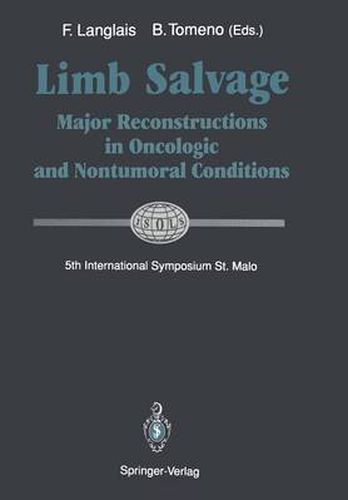Readings Newsletter
Become a Readings Member to make your shopping experience even easier.
Sign in or sign up for free!
You’re not far away from qualifying for FREE standard shipping within Australia
You’ve qualified for FREE standard shipping within Australia
The cart is loading…






This title is printed to order. This book may have been self-published. If so, we cannot guarantee the quality of the content. In the main most books will have gone through the editing process however some may not. We therefore suggest that you be aware of this before ordering this book. If in doubt check either the author or publisher’s details as we are unable to accept any returns unless they are faulty. Please contact us if you have any questions.
An international group ofresearchers has met every 2 years since 1981 to examine the progress made in limb salvage techniques and the perspectives of this field of surgery. In 1989 the Fifth International Symposium On Limb Salvage (ISOLS) was held in Saint Malo and was attended by more than 300 participants from 34 different countries. The 105 papers presented, grouped under eleven main headings, have been included in this book. Limb salvage has indeed progressed in the years since the first symposium. Initially it essentially concerned tumours and the main aim was to salvage the diseased limb through non-mutilating surgery without jeopardizing the patient’s prospects of survival. Now, with a confirmed high rate of 5-year disease-free survival, new goals can be set: improvement of the functional results and of the survival of our reconstructions. How can this be achieved: - By favouring muscle reattachment on the prosthesis, for instance through the use of a bone allograft-sleeved composite prosthesis? - By improving the survival of the arthroplasty through the develop ment of a more biological fixation of its stems? - By limiting the side effects of the necessary adjuvant treatments on the function of the allograft as well as on the fixation of the prosthesis? In addition, limb salvage procedures now concern not only primary tumours (and metastases, which must be treated using the same osteosynthetic and prosthetic techniques), but also reconstructive orthopaedic surgery as a whole.
$9.00 standard shipping within Australia
FREE standard shipping within Australia for orders over $100.00
Express & International shipping calculated at checkout
This title is printed to order. This book may have been self-published. If so, we cannot guarantee the quality of the content. In the main most books will have gone through the editing process however some may not. We therefore suggest that you be aware of this before ordering this book. If in doubt check either the author or publisher’s details as we are unable to accept any returns unless they are faulty. Please contact us if you have any questions.
An international group ofresearchers has met every 2 years since 1981 to examine the progress made in limb salvage techniques and the perspectives of this field of surgery. In 1989 the Fifth International Symposium On Limb Salvage (ISOLS) was held in Saint Malo and was attended by more than 300 participants from 34 different countries. The 105 papers presented, grouped under eleven main headings, have been included in this book. Limb salvage has indeed progressed in the years since the first symposium. Initially it essentially concerned tumours and the main aim was to salvage the diseased limb through non-mutilating surgery without jeopardizing the patient’s prospects of survival. Now, with a confirmed high rate of 5-year disease-free survival, new goals can be set: improvement of the functional results and of the survival of our reconstructions. How can this be achieved: - By favouring muscle reattachment on the prosthesis, for instance through the use of a bone allograft-sleeved composite prosthesis? - By improving the survival of the arthroplasty through the develop ment of a more biological fixation of its stems? - By limiting the side effects of the necessary adjuvant treatments on the function of the allograft as well as on the fixation of the prosthesis? In addition, limb salvage procedures now concern not only primary tumours (and metastases, which must be treated using the same osteosynthetic and prosthetic techniques), but also reconstructive orthopaedic surgery as a whole.